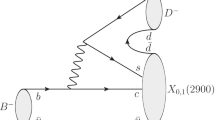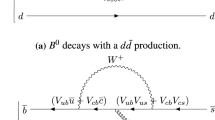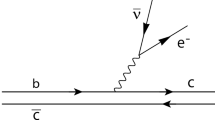Abstract
In this article, we take the X(5568) to be the scalar diquark–antidiquark type tetraquark state, study the hadronic coupling constant \(g_{XB_s\pi }\) with the three-point QCD sum rules by carrying out the operator product expansion up to the vacuum condensates of dimension-6 and including both the connected and the disconnected Feynman diagrams; then we calculate the partial decay width of the strong decay \( X(5568) \rightarrow B_s^0 \pi ^+\) and obtain the value \(\Gamma _X=\left( 20.5\pm 8.1\right) \,\mathrm {MeV}\), which is consistent with the experimental data \(\Gamma _X = \left( 21.9 \pm 6.4 {}^{+5.0}_{-2.5}\right) \,\mathrm {MeV}\) from the D0 collaboration.
Similar content being viewed by others
Avoid common mistakes on your manuscript.
1 Introduction
Recently, the D0 collaboration observed a narrow structure, X(5568), in the decay \(X(5568) \rightarrow B_s^0 \pi ^{\pm }\) with significance of \(5.1\sigma \) [1]. The measured mass and width are \(m_X =\left( 5567.8 \pm 2.9 { }^{+0.9}_{-1.9}\right) \,\mathrm {MeV} \) and \(\Gamma _X = \left( 21.9 \pm 6.4 {}^{+5.0}_{-2.5}\right) \,\mathrm {MeV}\), respectively. The D0 collaboration fitted the \(B_s^0 \pi ^{\pm }\) systems with the Breit–Wigner parameters in relative S-wave, the favored quantum numbers are \(J^P =0^+\). However, the quantum numbers \(J^P = 1^+\) cannot be excluded according to decays \(X(5568) \rightarrow B_s^*\pi ^+ \rightarrow B_s^0 \pi ^+ \gamma \), where the low-energy photon is not detected. There have been several possible assignments, such as the scalar-diquark–scalar-antidiquark type tetraquark state [2–7], axialvector-diquark–axialvector-antidiquark type tetraquark state [3, 8, 9], \(B^{(*)} \bar{K}\) hadronic molecule state [10], threshold effect [11].
The calculations based on the QCD sum rules indicate that both the scalar-diquark–scalar-antidiquark type and the axialvector-diquark–axialvector-antidiquark type interpolating currents can give satisfactory mass \(m_X\) to reproduce the experimental data [2–4, 8]. In Ref. [9], Agaev, Azizi and Sundu choose the axialvector-diquark–axialvector-antidiquark type interpolating current, they calculate the hadronic coupling constant \(g_{XB_s\pi }\) with the light-cone QCD sum rules in conjunction with the soft-\(\pi \) approximation and other approximations, and they obtain the partial decay width for the process \( X(5568) \rightarrow B_s^0 \pi ^+\). In Ref. [7], Dias et al. choose the scalar-diquark–scalar-antidiquark type interpolating current, calculate the hadronic coupling constant \(g_{XB_s\pi }\) with the three-point QCD sum rules in the soft-\(\pi \) limit by taking into account only the connected Feynman diagrams in the leading order approximation, and obtain the partial decay width for the decay \( X(5568) \rightarrow B_s^0 \pi ^+\). In previous work [2], we choose the scalar-diquark–scalar-antidiquark type interpolating current to study the mass of the X(5568) with the QCD sum rules. In this article, we extend our previous work to the study of the hadronic coupling constant \(g_{XB_s\pi }\) with the three-point QCD sum rules by carrying out the operator product expansion up to the vacuum condensates of dimension-6 and including both the connected and disconnected Feynman diagrams; then we calculate the partial decay width of the strong decay \( X(5568) \rightarrow B_s^0 \pi ^+\).
The article is arranged as follows: we derive the QCD sum rule for the hadronic coupling constant \( g_{XB_s\pi }\) in Sect. 2; in Sect. 3, we present the numerical results and discussions; and Sect. 4 is reserved for our conclusion.
2 QCD sum rule for the hadronic coupling constant \( g_{XB_s\pi }\)
We can study the strong decay \(X(5568)\rightarrow B_s^0\pi ^{+}\) with the three-point correlation function \(\Pi (p,q)\),
where the currents
interpolate the mesons \(B_s\), \(\pi \), and X(5568), respectively, the i, j, k, m, n are color indices, the C is the charge conjugation matrix. In Ref. [7], the axial vector current is used to interpolate the \(\pi \) meson.
At the hadron side, we insert a complete set of intermediate hadronic states with the same quantum numbers as the current operators \(J_{B_s}(x)\), \(J_{\pi }(y)\), and \(J_X(0)\) into the three-point correlation function \(\Pi (p,q)\) and isolate the ground state contributions to obtain the following result:
where \(p^\prime =p+q\), the \(f_{B_s}\), \(f_{\pi }\) and \(\lambda _{X}\) are the decay constants of the mesons \(B_s\), \(\pi \), and X(5568), respectively, and \(g_{XB_s\pi }\) is the hadronic coupling constant.
In the following, we write down the definitions:
The two unknown functions \(\rho _{X\pi }(p^2,t,p^{\prime 2})\) and \(\rho _{XB_s}(t,q^2,p^{\prime 2})\) have a complex dependence on the transitions between the ground state X(5568) and the excited states of the \(\pi \) and \(B_s\) mesons, respectively. We introduce the parameters \(C_{X\pi }\) and \(C_{X B_s}\) to parameterize the net effects,
and we rewrite the correlation function \(\Pi (p,q)\) into the following form:
We set \(p^{\prime 2}=p^2\) and take the double Borel transform with respect to the variable \(P^2=-p^2 \) and \(Q^2=-q^2\), respectively, to obtain the QCD sum rule at the left side (LS),
In calculations, we neglect the dependencies of the \(C_{X\pi }\) and \(C_{X B_s}\) on the variables \(p^2,\,p^{\prime 2},\,q^2\) therefore the dependencies of the \(C_{X\pi }\) and \(C_{X B_s}\) on the variables \(M_1^2\) and \(M_2^2\), we take the \(C_{X\pi }\) and \(C_{X B_s}\) as free parameters, and we choose the suitable values to eliminate the contaminations so as to obtain the stable sum rules with the variations of the Borel parameters [12–14].
Now we carry out the operator product expansion at the large Euclidean space-time region \(-p^2 \rightarrow \infty \) and \(-q^2 \rightarrow \infty \), take into account the vacuum condensates up to dimension 6 and neglect the contribution of the three-gluon condensate, as the three-gluon condensate is the vacuum expectation of the operator of the order \(\mathcal {O}( \alpha _s^{3/2})\). In other words, we calculate the Feynman diagrams shown in Fig. 1. For example, the first diagram is calculated in the following ways:
The operator product expansion converges for large \(-p^2\) and \(-q^2\), it is odd to take the limit \(q^2 \rightarrow 0\).
Then we set \(p^{\prime 2}=p^2\), take the quark–hadron duality below the continuum thresholds, and perform the double Borel transform with respect to the variables \(P^2=-p^2 \) and \(Q^2=-q^2\), respectively, to obtain the perturbative term,
where \(s_0\) and \(u_0\) are the continuum threshold parameters for the X(5568) and \(\pi \), respectively.
Other Feynman diagrams are calculated in analogous ways, and finally we obtain the QCD sum rules at the right side (RS),
The terms \(\langle \bar{q}q\rangle \langle \bar{s}s\rangle \) disappear after performing the double Borel transform, the last Feynman diagrams in Fig. 1 have no contribution.
In Refs. [14, 15], the width of the \(Z_c(4200)\) is studied with the three-point QCD sum rules by including both the connected and disconnected Feynman diagrams, which is contrary to Ref. [16], where only the connected Feynman diagrams are taken into account to study the width of the \(Z_c(3900)\). In this article, the contributions coming from the connected diagrams can be written as \(\mathrm{RS}_{c}\),
which is too small to account for the experimental data [1].
Finally, we obtain the QCD sum rule,
There appear some energy-scale dependence at the hadron side (or LS) of the QCD sum rule according to the factors \(m_u+m_d\) and \(m_b+m_s\), we can eliminate the energy-scale dependence by using the currents \(\widehat{J}_{B_s}(x)\) and \(\widehat{J}_{\pi }(y)\),
then
and
the resulting QCD sum rule at the right side also acquires a factor \(\left( m_b+m_s \right) \left( m_u+m_d \right) \), an equivalent QCD sum rule is obtained, the predicted hadronic coupling constant \(g_{XB_s\pi }\) is not changed.
We can also study the strong decay \(X(5568)\rightarrow B_s^0\pi ^{+}\) with the three-point correlation function \(\Pi _{\mu \nu }(p,q)\),
where the currents
interpolate the mesons \(B_s\) and \(\pi \), respectively. At the hadron side, we insert a complete set of intermediate hadronic states with the same quantum numbers as the current operators \(\eta _{\mu }^{\bar{s} b}(x)\) and \(\eta _{\nu }^{\bar{u} d}(y)\) into the three-point correlation function \(\Pi _{\mu \nu }(p,q)\) and isolate the ground state contributions to obtain the following result:
where \(p^\prime =p+q\), the \(f_{B_{s1}}\), \(f_{B_{s}}\), \(f_{a_1}\), and \(f_{\pi }\) are the decay constants of the mesons \(B_{s1}(5830)\), \(B_s\), \(a_1(1260)\), and \(\pi \), respectively, the \(g_{X B_{s1}\pi }\) and \(g_{X B_{s1} a_1}\) are the hadronic coupling constants.
In the following, we write down the definitions:
where the \(\varepsilon _\mu \) and \(\epsilon _\nu \) are polarization vectors of the axialvector mesons \(B_{s1}(5830)\) and \(a_1(1260)\), respectively. From the values \(m_X =\left( 5567.8 \pm 2.9 { }^{+0.9}_{-1.9}\right) \,\mathrm {MeV} \) [1], \(m_{B_{s1}}=\left( 5828.40\pm 0.04\pm 0.41\right) \,\mathrm {MeV}\), \(m_{B_{s}}=\left( 5366.7 \pm 0.4\right) \,\mathrm {MeV}\) [17], we can obtain \(m_{B_{s1}}-m_{B_{s}}\approx 462\,\mathrm {MeV}\) and \(m_{B_{s1}}-m_{X}\approx 261\,\mathrm {MeV}\). If we take the interpolating currents \(\eta _{\mu }^{\bar{s} b}(x)\) and \(\eta _{\nu }^{\bar{u} d}(y)\), there are contaminations from the axialvector mesons \(B_{s1}(5830)\) and \(a_1(1260)\). We should multiply both sides of Eq.(19) by \(p^\mu q^\nu \) to eliminate the contaminations of the axialvector mesons \(B_{s1}(5830)\) and \(a_1(1260)\) to find
which corresponds to taking the pseudoscalar currents \(\widehat{J}_{B_s}(x)\) and \(\widehat{J}_{\pi }(y)\) according to the identities
The axialvector currents \(\eta _{\mu }^{\bar{s} b}(x)\) and \(\eta _{\nu }^{\bar{u} d}(y)\) can also be chosen to study the strong decay \(X(5568)\rightarrow B_s^0\pi ^{+}\).
We also expect to study the strong decay \(X(5568)\rightarrow B_s^0\pi ^{+}\) with the light-cone QCD sum rules using the two-point correlation function \(\overline{\Pi }(p,q)\),
where the \(\langle \pi (q)|\) is an external \(\pi \) state.
At the QCD side, we obtain the following result after performing the Wick contraction:
where the \(S_s^{kl}(-x)\) and \(S_b^{ln}(x)\) are the full s and b quark propagators, respectively. The u and \(\bar{d}\) quarks stay at the same point \(x=0\), the light-cone distribution amplitudes of the \(\pi \) meson are almost useless, the integrals over the \(\pi \) meson’s light-cone distribution amplitudes reduce to overall normalization factors. In the light-cone QCD sum rules, such a situation is possible only in the soft pion limit \(q \rightarrow 0\), and the light-cone expansion reduces to the short-distance expansion [18]. In Ref. [9], Agaev, Azizi and Sundu take the soft pion limit \(q \rightarrow 0\), and choose the \(C\gamma _\mu \otimes \gamma ^\mu C\) type current to interpolate the X(5568), and use the light-cone QCD sum rules to study the strong decay \(X(5568)\rightarrow B_s^0\pi ^{+}\). The light-cone QCD sum rules are reasonable only in the soft pion approximation.
3 Numerical results and discussions
The hadronic parameters are taken as \(m_{X}=5.5678\,\mathrm {GeV}\) [1], \(\lambda _{X}=6.7\times 10^{-3}\,\mathrm {GeV}^5\), \(\sqrt{s_{0}}=(6.1\pm 0.1)\,\mathrm {GeV}\) [2], \(m_{\pi }=0.13957\,\mathrm {GeV}\), \(m_{B_s}=5.3667\,\mathrm {GeV}\) [17], \(f_{\pi }=0.130\,\mathrm {GeV}\), \(\sqrt{u_{0}}=(0.85\pm 0.05)\,\mathrm {GeV}\) [19], \(f_{B_s}=0.231 \,\mathrm {GeV}\) [20, 21], \(f_{\pi }m^2_{\pi }/(m_u+m_d)=-2\langle \bar{q}q\rangle /f_{\pi }\) from the Gell-Mann–Oakes–Renner relation, and \(M_2^2=(0.8-1.2)\,\mathrm {GeV}^2\) from the QCD sum rules [19]. At the QCD side, the vacuum condensates are taken to be standard values, \(\langle \bar{q}q \rangle =-(0.24 \pm 0.01\, \mathrm {GeV})^3\), \(\langle \bar{s}s \rangle =(0.8 \pm 0.1)\langle \bar{q}q \rangle \), \(\langle \bar{q}g_s\sigma G q \rangle =m_0^2\langle \bar{q}q \rangle \), \(\langle \bar{s}g_s\sigma G s \rangle =m_0^2\langle \bar{s}s \rangle \), \(m_0^2=(0.8 \pm 0.1)\,\mathrm {GeV}^2\) and \(\langle \frac{\alpha _s GG}{\pi }\rangle =(0.33\,\mathrm {GeV})^4\) at the energy scale \(\mu =1\, \mathrm {GeV}\) [22, 23]. The quark condensates and mixed quark condensates evolve with the renormalization group equation, \(\langle \bar{q}q \rangle (\mu )=\langle \bar{q}q \rangle (Q)\left[ \frac{\alpha _{s}(Q)}{\alpha _{s}(\mu )}\right] ^{\frac{4}{9}}\) and \(\langle \bar{q}g_s \sigma Gq \rangle (\mu )=\langle \bar{q}g_s \sigma Gq \rangle (Q)\left[ \frac{\alpha _{s}(Q)}{\alpha _{s}(\mu )}\right] ^{\frac{2}{27}}\), where \(q=u,d,s\).
In this article, we take the \(\overline{MS}\) masses \(m_{b}(m_b)=(4.18\pm 0.03)\,\mathrm {GeV}\) and \(m_s(\mu =2\,\mathrm {GeV})=(0.095\pm 0.005)\,\mathrm {GeV}\) from the Particle Data Group [17], and we take into account the energy-scale dependence of the \(\overline{MS}\) masses from the renormalization group equation,
where \(t=\log \frac{\mu ^2}{\Lambda ^2}\), \(b_0=\frac{33-2n_f}{12\pi }\), \(b_1=\frac{153-19n_f}{24\pi ^2}\), \(b_2=\frac{2857-\frac{5033}{9}n_f+\frac{325}{27}n_f^2}{128\pi ^3}\), \(\Lambda =213\,\mathrm {MeV}\), \(296\,\mathrm {MeV}\) and \(339\,\mathrm {MeV}\) for the flavors \(n_f=5\), 4, and 3, respectively [17]. Furthermore, we set the u and d quark masses to be zero. In the heavy quark limit, the b-quark can be taken as a static potential well, and unchanged in the decay \(X(5568)\rightarrow B_s^0 \pi ^+\). In this article, we take the typical energy scale \(\mu =m_b\).
The unknown parameter is chosen as \(C_{XB_s}=-0.00059\,\mathrm {GeV}^8 \). There appears a platform in the region \(M_1^2=(4.5-5.5)\,\mathrm {GeV}^2\). Now we take into account the uncertainties of the input parameters and obtain the value of the hadronic coupling constant \(g_{XB_s\pi }\), which is shown explicitly in Fig. 2,
Now we obtain the partial decay width,
The decays \(X(5568) \rightarrow B^+\bar{K}^{0}\) are kinematically forbidden, so the width \(\Gamma _{X}\) can be saturated by the partial decay width \(\Gamma \left( X(5568) \rightarrow B_s^0 \pi ^+\right) \), which is consistent with the experimental value \(\Gamma _X = 21.9 \pm 6.4 {}^{+5.0}_{-2.5}\,\mathrm {MeV}\) from the D0 collaboration [1]. The present work favors assigning the X(5568) to be the scalar diquark–antidiquark type tetraquark state.
In the following, we perform a Fierz re-arrangement to the current \(J_X\) both in the color and Dirac-spinor spaces to obtain the result
the components \(\bar{b}i\gamma _5 s\,\bar{d}i\gamma _5 u\) and \(\bar{b} \gamma ^\mu \gamma _5 s\,\bar{d}\gamma _\mu \gamma _5 u\) couple potentially to the meson pair \(B_s\pi ^{+}\), while the components \(\bar{b}i\gamma _5 u\,\bar{d}i\gamma _5 s\) and \(\bar{b} \gamma ^\mu \gamma _5 u\,\bar{d}\gamma _\mu \gamma _5 s\) couple potentially to the meson pair \(B^+\bar{K}^0\). The strong decays
are Okubo–Zweig–Iizuka super-allowed, while the decays
are kinematically forbidden, which is consistent with the observation of the D0 collaboration [1]. In previous work, we observed that the \(C\gamma _5\otimes \gamma _5C\) type hidden-charm tetraquark states have slightly smaller masses than the \(C\gamma _\mu \otimes \gamma ^\mu C\) type hidden-charm tetraquark states; the predicted lowest masses are \(m_{C\gamma _5\otimes \gamma _5C}=\left( 3.82^{+0.08}_{-0.08}\right) \,\mathrm {GeV}\) and \(m_{C\gamma _\mu \otimes \gamma ^\mu C}=\left( 3.85^{+0.15}_{-0.09}\right) \,\mathrm {GeV}\) [24, 25]. We expect that a \(C\gamma _\mu \otimes \gamma ^\mu C\) type current can also reproduce the experimental value \(m_X =\left( 5567.8 \pm 2.9 { }^{+0.9}_{-1.9}\right) \,\mathrm {MeV} \) approximately [3, 8].
Now we construct the current \(\eta _{X}\) and perform a Fierz re-arrangement both in the color and Dirac-spinor spaces to obtain the following result:
the components \(\bar{b}i\gamma _5 s\,\bar{d}i\gamma _5 u\) and \(\bar{b} \gamma ^\mu \gamma _5 s\,\bar{d}\gamma _\mu \gamma _5 u\) couple potentially to the meson pair \(B_s\pi ^{+}\), while the components \(\bar{b}i\gamma _5 u\,\bar{d}i\gamma _5 s\) and \(\bar{b} \gamma ^\mu \gamma _5 u\,\bar{d}\gamma _\mu \gamma _5 s\) couple potentially to the meson pair \(B^+\bar{K}^0\), which is analogous to the current \(J_X\). It is also sensible to assign the X(5568) to be an axialvector-diquark–axialvector-antidiquark type tetraquark state or the X(5568) has some axialvector-diquark–axialvector-antidiquark type tetraquark components.
The \(C\otimes C\) type current \(\widetilde{J}_{X}\) and \(C\gamma _\mu \gamma _5 \otimes \gamma _5\gamma ^\mu C \) type current \(\widetilde{\eta }_{X}\) are expected to couple potentially to the scalar tetraquark with much larger masses,
as the favored configurations are the scalar diquarks (\(C\gamma _5\)-type) and axialvector diquarks (\(C\gamma _\mu \)-type) from the QCD sum rules [26–28].
4 Conclusion
In this article, we take X(5568) to be the scalar diquark–antidiquark type tetraquark state, we study the hadronic coupling constant \(g_{XB_s\pi }\) with the three-point QCD sum rules, then we calculate the partial decay width of the strong decay \( X(5568) \rightarrow B_s^0 \pi ^+\) and obtain the value \(\Gamma _X=\left( 20.5\pm 8.1\right) \,\mathrm {MeV}\), which is consistent with the experimental data, \(\Gamma _X = \left( 21.9 \pm 6.4 {}^{+5.0}_{-2.5}\right) \,\mathrm {MeV}\), from the D0 collaboration. In the calculation, we carry out the operator product expansion up to the vacuum condensates of dimension-6, and we take into account both the connected and disconnected Feynman diagrams. The present prediction favors assigning the X(5568) to the diquark–antidiquark type tetraquark state with \(J^P=0^+\). However, the quantum numbers \(J^P = 1^+\) cannot be excluded according to the decays \(X(5568) \rightarrow B_s^*\pi ^+ \rightarrow B_s^0 \pi ^+ \gamma \), where the low-energy photon is not detected.
References
V.M. Abazov et al, arXiv:1602.07588
Z.G. Wang, arXiv:1602.08711
W. Chen, H.X. Chen, X. Liu, T.G. Steele, S.-L. Zhu, arXiv:1602.08916
C.M. Zanetti, M. Nielsen, K.P. Khemchandani, arXiv:1602.09041
W. Wang, R. Zhu, arXiv:1602.08806
Y.R. Liu, X. Liu, S.L. Zhu, arXiv:1603.01131
J.M. Dias, K.P. Khemchandani, A.M. Torres, M. Nielsen, C.M. Zanetti, arXiv:1603.02249
S.S. Agaev, K. Azizi, H. Sundu, arXiv:1602.08642
S.S. Agaev, K. Azizi, H. Sundu, arXiv:1603.00290
C.J. Xiao, D.Y. Chen, arXiv:1603.00228
X.H. Liu, G. Li, arXiv:1603.00708
B.L. Ioffe, A.V. Smilga, Nucl. Phys. B 232, 109 (1984)
Z.G. Wang, W.M. Yang, S.L. Wan, Phys. Rev. D 72, 034012 (2005)
Z.G. Wang, Int. J. Mod. Phys. A 30, 1550168 (2015)
W. Chen, T.G. Steele, H.X. Chen, S.L. Zhu, Eur. Phys. J. C 75, 358 (2015)
J.M. Dias, F.S. Navarra, M. Nielsen, C.M. Zanetti, Phys. Rev. D 88, 016004 (2013)
K.A. Olive et al., Chin. Phys. C 38, 090001 (2014)
V.M. Belyaev, V.M. Braun, A. Khodjamirian, R. Ruckl, Phys. Rev. D 51, 6177 (1995)
P. Colangelo, A. Khodjamirian, arXiv:hep-ph/0010175
Z.G. Wang, JHEP 1310, 208 (2013)
Z.G. Wang, Eur. Phys. J. C 75, 427 (2015)
M.A. Shifman, A.I. Vainshtein, V.I. Zakharov, Nucl. Phys. B 147(385), 448 (1979)
L.J. Reinders, H. Rubinstein, S. Yazaki, Phys. Rep. 127, 1 (1985)
Z.G. Wang, Mod. Phys. Lett. A 29, 1450207 (2014)
Z.G. Wang, Commun. Theor. Phys. 63, 466 (2015)
Z.G. Wang, Eur. Phys. J. C 71, 1524 (2011)
R.T. Kleiv, T.G. Steele, A. Zhang, Phys. Rev. D 87, 125018 (2013)
Z.G. Wang, Commun. Theor. Phys. 59, 451 (2013)
Acknowledgments
This work is supported by National Natural Science Foundation, Grant Number 11375063, and Natural Science Foundation of Hebei province, Grant Number A2014502017.
Author information
Authors and Affiliations
Corresponding author
Rights and permissions
Open Access This article is distributed under the terms of the Creative Commons Attribution 4.0 International License (http://creativecommons.org/licenses/by/4.0/), which permits unrestricted use, distribution, and reproduction in any medium, provided you give appropriate credit to the original author(s) and the source, provide a link to the Creative Commons license, and indicate if changes were made.
Funded by SCOAP3
About this article
Cite this article
Wang, ZG. Analysis of the strong decay \(X(5568) \rightarrow B_s^0\pi ^+\) with QCD sum rules. Eur. Phys. J. C 76, 279 (2016). https://doi.org/10.1140/epjc/s10052-016-4133-6
Received:
Accepted:
Published:
DOI: https://doi.org/10.1140/epjc/s10052-016-4133-6






